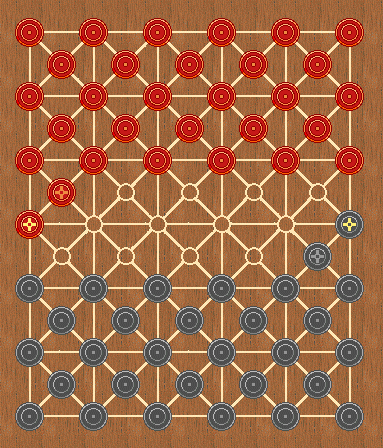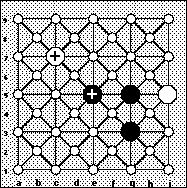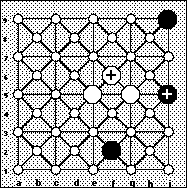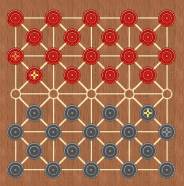

Rules
This game derives from Lapland. Goal is either to capture the enemy king or reduce his forces so that only the king remains. All pieces move by single steps and can capture, by the short leap, in all directions. The soldier (“dårake”) can only step in the three forward directions. Promotion does not occur. For the soldier, capture is mandatory. For the king (“gånneka”) and prince (“gånnekan alke”), capture is optional. One can only capture a piece of the same rank or lower. Pieces are ranked in this order: king, prince, and soldier.
A piece moves to an empty adjacent point. If an adjacent point is occupied by an enemy piece, of the same rank or lower, and the point directly behind is vacant, then one may jump over it and capture it, as in checkers. Several pieces may be captured like this in a single turn. Dablo Frostviken follows the same rules.
 Example of simple combination. Here black can win by moving the king to the left (e5-c5). This forces white to capture the soldier, which leaves the king en prise.
Example of simple combination. Here black can win by moving the king to the left (e5-c5). This forces white to capture the soldier, which leaves the king en prise.
 Another typical combination. Black moves the soldier to nw (f2-e3), forcing the white soldier to capture. Thus, black can capture the enemy king in two consecutive jumps.
Another typical combination. Black moves the soldier to nw (f2-e3), forcing the white soldier to capture. Thus, black can capture the enemy king in two consecutive jumps.
Discussion
Dablot Prejjesne was played among the Sámi people (the “Lapps”) in Sweden. The name is Laplandish and means “To play Dablo on a board”. The first party represents the Lapps, and the second party represents the Peasants. The pieces were carved in wood. Mandatory capture on part of the soldier, its forward movement restriction, and the rule of absolute royal pieces, are suggested in this reconstruction. The absolute king rule is corroborated by a note on Dablot Prejjesne from 1892 by Wiklund: “The party who first loses all his counters has lost the game. According to agreement, the player also loses whose king is jumped over and thus captured by the other king, in which case normal counters cannot capture the king” (my transl.) [“Den som först förlorat alla sina brickor, har tappat. Efter öfverenskommelse kan äfven den tappa, hvars kung blifvit öfverhoppat och slagen af den andres kung; vanliga brickor kunna då ej slå kungarna”]. There also seem to have existed smaller dablo variants where king capture was sufficient for a win. Pettersson says that in certain parts of Lapland has the rule of forward movement only been introduced, at least for the soldiers. This is also borne out by Anta Pirak’s description of “tablo” (1937, pp.17-18). The soldier’s mandatory capture remains a point of contention.
Dablot Prejjesne is closely related to Dablo Daares (here). An interesting fact is that the board has the same type of pattern as the African game Kharbaga (here), and the capture rules are reminiscent of the Italian checkers variant Damone (here). The ‘absolute king’ rule is reminiscent of Italian Damone variants, where capture of the Damones is sufficient for a win. The suggested ‘lone king’ rule exists also in Shatranj (here). The notion of forward moving pieces that do not promote, but can capture in all directions, is known from Ossetian checkers (here).
As capture is mandatory for the soldier, it is sometimes possible to sacrifice one or more soldiers to enemy soldiers, and thus to create a situation where the enemy king or prince can be captured. But it is not always adequate to make such combinations, if it leaves the opponent with a clear majority of soldiers, together with his remaining king. It is necessary to hunt enemy soldiers with the royal pieces, although this exposes them to combinations. A shortage of soldiers can lead to a lost game as it allows the opponent to continue exchanging soldiers until he wins according to the ‘lone king’ rule.
In N. Keyland’s rendition of standard Dablot Prejjesne rules, the game is very tedious when soldier capture is not mandatory, the soldier can step in all directions (a lot of back and forth), and you must remove all enemy pieces to win. In order to end the game, when only few pieces remain (likely to occur after 200 moves or so) the players are expected to move straight forward with the pieces (although the pieces can also move backwards), and the player who is lucky enough to arrive at a position where he has the capture right can win the game. This is a completely erratic rule that perhaps was invented in late times to try to make sense of the game. Instead I propose that it is enough to capture the king to win (corroborated by historical variants), and that capture by the soldier is mandatory, so that it becomes possible to capture the royal pieces by way of sacrificial combinations.
Mandatory capture for both king and prince would not work, while there exists a forced royal piece win in the initial position. With these rules the game is strategically and tactically very interesting, and takes appropriately long time, too.
Promotion
A suggested variant introduces the rule that Soldiers promote to Prince when they reach the farthest rank. However, capture takes precedence before promotion.
Dablo Frostviken
 Wiklund also describes a 41 square variant with, in all, 18 pieces per side, including king and prince. It is known to have been played in Frostviken, Lapland. Accordingly, I have named this Dablo Frostviken. It is also implemented.
Wiklund also describes a 41 square variant with, in all, 18 pieces per side, including king and prince. It is known to have been played in Frostviken, Lapland. Accordingly, I have named this Dablo Frostviken. It is also implemented.
References
Keyland, N. (1921). ‘Dablot prejjesne och Dablot duoljesne’. Etnologiska Studier. Göteborg.
Pennick, N. (1988). Games of the Gods. Rider.
Pirak, A. (1937). En nomad och hans liv. Stockholm: Nord.
Wiklund, K.B. (1892). Note: catalogue nr. 71978. Nordiska Museet (Stockholm, Sweden).
This is a reworking of my earlier reconstruction, following P. Michaelsen’s suggested reconstruction, to which I’ve added some ideas.
☛ You can download my free Dablot prejjesne program here (updated 2020-10-18), but you must own the software Zillions of Games to be able to run it. (I recommend the download version.)
© Mats Winther 2006-2010